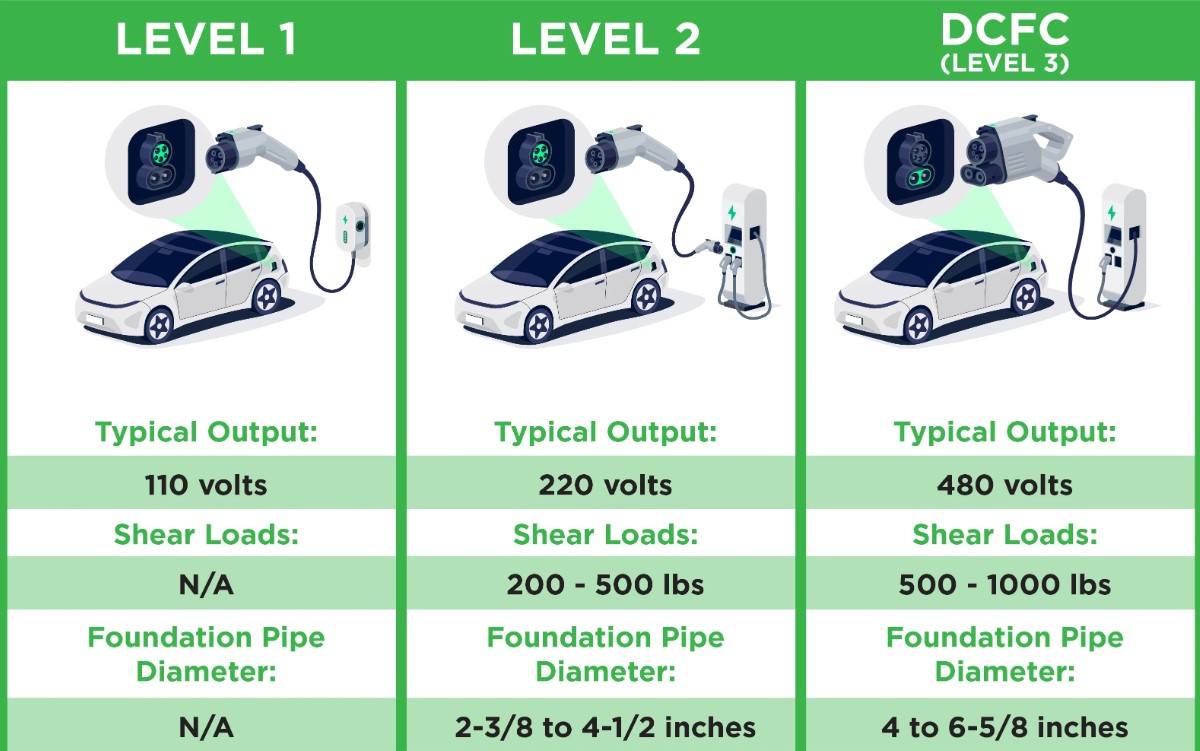EV Charger Level 3 Stations 2024 – KW, Cost, Voltage At Home
 Level 3 is the most powerful and fastest in electric car charging system. These modern charging stations convert alternating current from the grid to direct current before it reaches the vehicle, bypassing the slow onboard converter and unlocking much faster speeds. That’s why Level 3 is also referred to as DC charging.
Level 3 is the most powerful and fastest in electric car charging system. These modern charging stations convert alternating current from the grid to direct current before it reaches the vehicle, bypassing the slow onboard converter and unlocking much faster speeds. That’s why Level 3 is also referred to as DC charging.
These advanced charging stations supply 50 kilowatts (kW) to 400 kW of power directly to your vehicle’s battery. The average time to charge a mid-sized electric car can be 15 to 55 minutes. In this article, we will discuss Level 3 charging in detail. Let’s dive into the article and gather detailed information. Solar Charging Stations for the Electric Vehicle Boom Map
How Does the Level 3 Charging Station Work?
Below is how Level 3 charging works. Let’s know the details.
We know that the power from the grid is alternating current as AC. It may be known to many that EV batteries receive direct current DC. So, to charge an EV’s battery, current from the grid must be converted from AC to DC. With Level 3 charging, this conversion occurs via an onboard charger before the electricity reaches the vehicle. This bypasses the slow onboard charger and directly charges the car battery.
Although Level 3 chargers come in many shapes and sizes, they all share one thing: the conversion occurs outside the vehicle. As a result, this charging station can deliver power at high speed.
Can Level 3 Chargers be used at Home and Any EV?
Do you want to install a Level 3 charger at home? But the first thing you need to do is to have an industrial-grade power connection in your home. Because we know that to achieve the speed required for fast charging, Level 3 chargers require up to 350 kW of very high-power current.
Due to cost and complexity, level 3 charging stations must still be suitable for home installations. They are still used in public and commercial settings for quick top-ups.
As we know from trusted websites, Level 3 charging can work with almost all modern EVs. Tesla makes these charging stations compatible with its models. However, some models must use an adapter. Depending on the vehicle’s power management, batteries can take up to 350 kilowatts, and some car batteries can only take up to 50 kilowatts. Vehicles with smaller or older batteries may not support EV Charger Level 3.
Level 3 Charging for Electric Mobility:
One of the main factors preventing EV drivers from purchasing an electric vehicle is the fear of being unable to charge it when needed. To accelerate the mass adoption of electric mobility, the charging experience should be quick and convenient. It is possible to charge in one hour using Level 3 charging.
Level 3 charging stations will undoubtedly make fast charging more accessible to EV drivers and reduce range anxiety. Level 3 charging predicts future electric mobility.
How much does it cost to charge an EV with Level 3 charging?
Level 3 will be expensive in terms of charging. The average price for a full Level 3 charging session ranges from $25 to $50. Electric cars are paying in part for the convenience of extra fast charging.
EVDC-360NA
- Model Number: EVDC-360NA
- Output Power: 360kW
- Output Voltage: 300 -1000V
- Output Current: 400A 0 – 400A variable range
- Width: 37.4” / 950mm
- Depth: 30.7” / 780mm
- Height: 89.8” / 2280mm
EVDC-180EU
- Model Number: EVDC-180EU
- Output Power: 180kW
- Output Voltage: 300 -1000V
- Output Current: 300A 0 – 300A variable range
- Width: 35.4” / 900m
- Depth: 22.4” / 570mm
- Height: 63.0” / 1600mm
EVDC-120S-EU
- Model Number: EVDC-120S-EU
- Output Power: 120kW (can split power to charge two EVs simultaneously)
- Output Voltage: 300 -1000V
- Supply Input: 400VAC (+/- 10%) three-phase / 50Hz
- Input Current: 177A (400VAC)
- Width: 39.4” / 1000mm
- Depth: 27.6” / 702mm
- Height: 86.6” / 2200mm
EVDC-120S-EU Features
- Open Charge Point Protocol (OCPP) 1.6 and ISO 15118 (Plug & Charge) compliant
- Driver friendly with a 10 inch LCD touchscreen and simple to use interface
- Start modes include plug-n-play, RFID, OCPP, and optional POS
- Ethernet, 4G and Wi-Fi connections available






